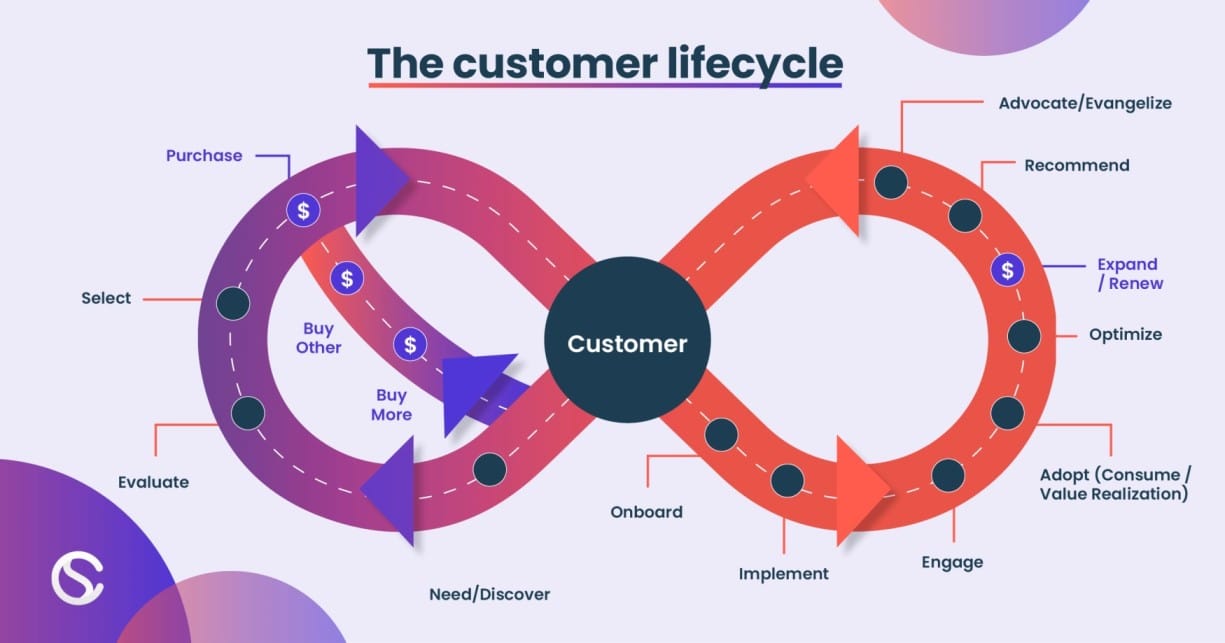Albert Einstein once said, "The world as we have created it is a process of our thinking. It cannot be changed without changing our thinking."
These wise words ring true when it comes to transforming businesses in today's climate. I’m not saying anything that’s not already been said over the last twelve months: every company across every industry is going through massive, sweeping change. But what’s the key difference between companies that thrive vs. the ones that merely survive? Their outlook.
Having a customer-centric outlook sounds like business jargon, but it couldn’t be simpler. Without customers, our businesses would cease to exist. There’s no going forward without our customers. Our customers should, therefore, be our number one priority; before our product, before the sales we make.
In this article, I’m going to explore:
- What customer success truly means
- What customer experience means
- Why the customer lifecycle needs to be re-approached
- Where to start when building a customer success culture
- How to elevate your customer success function
- Why your relationships are everything
What is customer success?
Okay, let's dig into what customer success really means from a philosophical and practical standpoint. At previous companies, we've called it "CXS" – is it a culture? A philosophy? A portfolio and doctrine? A mixture of team culture and philanthropy? The answer is... it's truly all of the above.
Here's my vision and mission statement for delivering the best, most comprehensive customer experience in our industry:
To accelerate success for our customers and drive profitable growth for our organization and our partners.
Our core values, which underpin this, are being relentlessly customer-obsessed, building trust, delivering trusted experiences, and strengthening ourselves together through partnership.
Our mission is to maximize the value and empower our customers to realize their trusted investments through best practices and partnerships at every stage of their journey.
This aligns with what Satya Nadella, CEO of Microsoft, said back in 2015 as the subscription economy was ramping up:
"Revenue and profit are lagging indicators of success not leading indicators. The question is how is data helping you stay in touch with what is happening."

Prioritize the customer experience
At its core, customer experience is the perception customers have of our brand throughout their entire lifecycle. From the very first moment, they become aware they have a need that requires a solution through the evaluation and vendor selection phase, to purchasing and onboarding, then implementation and long-term usage.
It's like a high-stakes Formula 1 endurance race – we're not just going pedal to the metal and hoping for the best. We have to go faster and smarter, in sync with the customer, as one unified force. Stronger together, every step of the way.
It's about continuously building value and trust at every single touchpoint, delivering "air-to-air" refueling to ensure they stay on track and keep accelerating value delivery. Then, they'll return the favor by remaining a loyal, satisfied customer.
A customer's perception of our brand – exemplified through their experience – is the reality of the value we deliver. Nothing, I repeat nothing, is more important than obsessing over the customer experience.
Why we need to transform to a customer lifecycle
The driving force behind this transformational shift is that customer value is no longer derived solely from the initial sale. Value must be continuously delivered across the entire customer lifecycle.

I want my customers to not only choose and use our solutions but also truly love our brand. I want them to view our organization as trusted advisors they can come back to at any point in their journey for guidance.
It all starts with relationships – building deep, trusted connections with all stakeholders to fully understand the customer's internal culture, processes, and landscape. It's about defining the mutually agreed upon values, goals, and success plans. Then aligning the right resources with the right expertise at exactly the right time.
I operate at the heart of this customer success culture. My role is driving relentless execution to ensure we grow each customer from their current state to their desired future state, one milestone at a time. Their success is intertwined with my success.
Where to start when building a customer success culture
The first key question to consider is, "What's in it for me?" from the perspective of other teams and individuals you need to engage. If you want cross-functional support and collaboration, you need to articulate how customer success efforts can benefit them.
For example, with sales teams, highlight how CS can help them retire their quotas faster by nurturing existing customers for expansion and renewals. This frees up time for new business acquisitions. Frame it as a mutually beneficial partnership.
Embracing a customer success culture is not just the responsibility of one person, team, or department. It requires an organizational mindset shift.

Balancing competing priorities
As a customer success function scales, it’s imperative to implement a tiered service model balancing low-touch, tech-touch, and high-touch engagement based on account scoring/prioritization rules. This allows focusing higher-touch resources on the most critical accounts.
Tips on building a customer success culture in a startup
The startup mindset is very important. Any startup should embrace and appreciate change every day. How to do this? You can hire for attributes like curiosity, problem-solving ability, and comfort with change – these skills can be trained.
Customer success is a team effort requiring cross-functional alignment. If you are pursuing a SaaS model, invest in CS from the outset. Acquiring new customers is not enough—you must drive adoption and renewals.

How to elevate your customer success function
Why customer health should be your go-to success metric
Determining key metrics to monitor customer health depends on the specific business. However, an effective approach incorporates both objective and subjective scoring components:
| Objective health scoring | Subjective health scoring |
|---|---|
| Data-driven indicators like login rates, feature usage, support tickets, etc. These provide quantifiable measures of product adoption and value realization. | More qualitative assessments based on periodic customer conversations to gauge sentiment, roadblocks, future needs, etc. This provides important context around the raw data. |
Developing relevant customer success plans
Success planning is very strategic and very core to customer success. They’re sets of tasks that guide you as a Northstar, helping your customers to align and understand the business priorities and outcomes of your customers.
Effective success plans:
- Reverse engineer a customer's goals through deep discovery and root cause analysis
- Translate product capabilities into specific business value
- Provide an actionable series of tasks with owners and due dates
- Incorporate ongoing risk assessment and course correction
Success planning requires strategic thinking to truly understand the "why" behind a customer's objectives and choreograph the right resources/activities accordingly. It is an iterative process, not a one-time static plan.

Relationships are everything
Customer success isn't just the latest buzzword, trend, or process to be implemented. It's a wholesale cultural transformation and mindset shift for organizations. One centered around developing enduring long-term, trusted, value-driven relationships from the very first interaction through renewals, repeat purchases and growth.
It fundamentally starts by evolving our mental model from merely closing a sale to fostering meaningful, measurable, successful outcomes for our customers through deep partnership.
With a laser focus on exceptional experience delivery and empowering customers to continually achieve their desired future state, we build an unbreakable culture of trusted advisors who are truly obsessed with making our customers wildly successful. Not just order-takers.
One united force of expertise, one comprehensive lifecycle philosophy, one unwavering mission – making our customers' businesses thrive.
TL;DR
- Customer success = customer experience + customer outcomes
- We're stronger together. No single person or team can achieve sustainable success alone. I'm the orchestrator bringing in the right expertise at the right time.
- It's all about realizing continuous value throughout the entire customer lifecycle – from initial onboarding to ongoing optimization to renewals and expansions.
Don't get customer success FOMO!
This article was based on a keynote presentation Bassam delivered at our Customer Success Festival in October 2021.
Join a room full of enthusiastic CS peers for two days of non-stop networking, knowledge-sharing, keynotes, roundtables, and more at one of our Customer Success Festivals – either in-person or virtual.
We assemble customer success champions from the world's most innovative and forward-thinking companies in the space. All rallied around one, shared goal: ensuring your customers reach their desired outcomes.
Whether it's New York, London, or from the comfort of your own computer, you'll return to your desk re-energized and equipped with proven tips, strategies and a whole host of valuable new industry connections.


